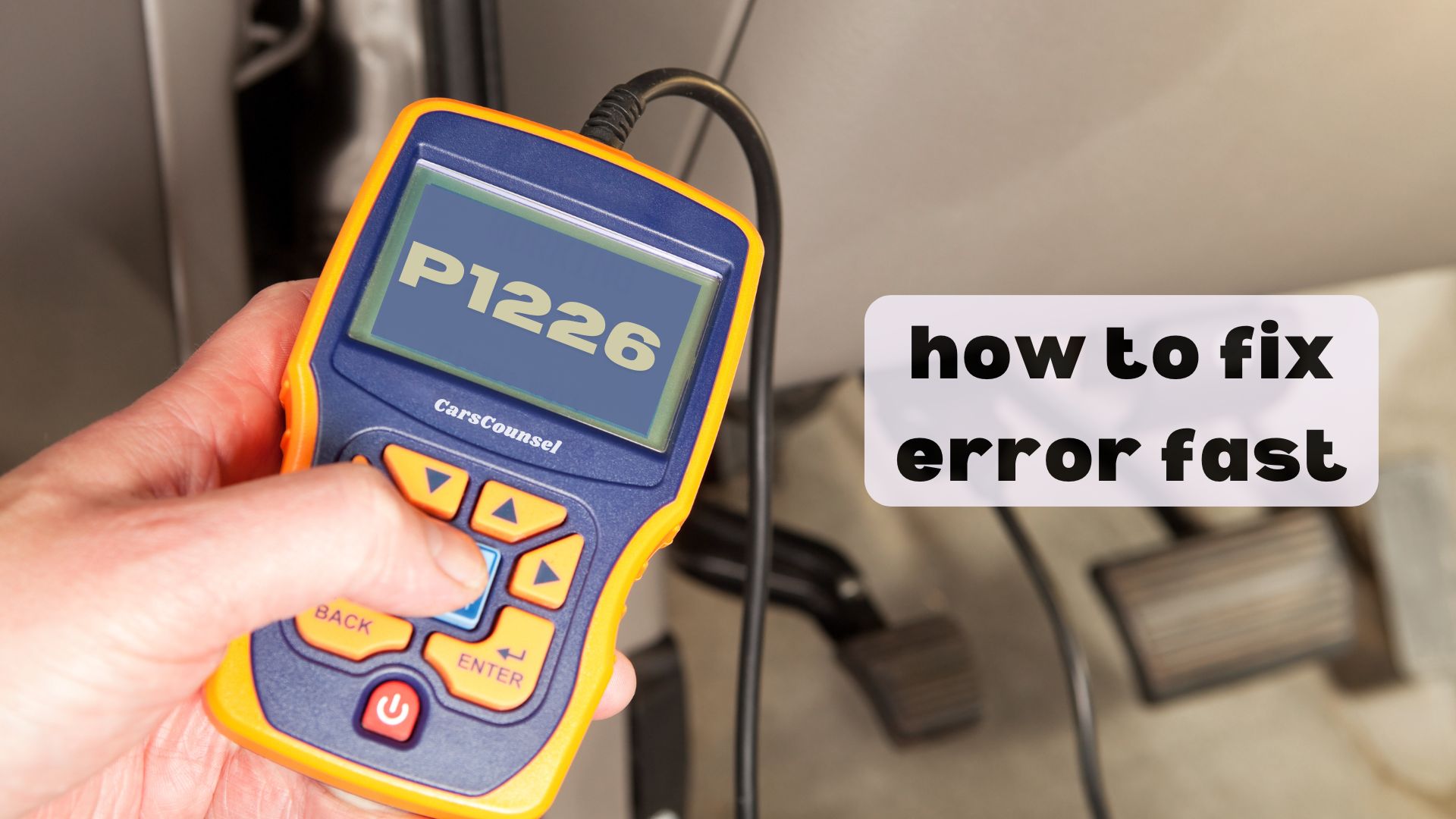You might not know that your engine control module (ECM) is constantly learning and adapting to your driving habits, including how you handle the throttle. But when the ECM encounters a problem with this learning process, it triggers the P1226 code, indicating a Closed Throttle Position Learning Performance Problem. This can lead to frustrating issues like rough idling and decreased fuel efficiency. What’s causing the malfunction, and how can you get your engine running smoothly again?

Quick Navigation
Key Takeaways
- The P1226 code indicates a Closed Throttle Position Learning Performance Problem in the engine control module (ECM), affecting engine performance and driving experience.
- Sensor malfunctions, throttle troubles, wiring issues, and ECM software glitches are common causes of the P1226 code, requiring diagnosis and repair.
- Symptoms of P1226 include rough engine performance, erratic idling, engine hesitation, decreased fuel efficiency, and the illuminated Check Engine Light.
- To fix P1226, diagnose the code by inspecting the throttle position sensor, idle air control valve, wiring, and connections, and replace faulty components as needed.
- A throttle relearn procedure may be necessary to recalibrate the closed throttle position in the ECM and resolve the issue.
Code P1226 Description
When the engine control module (ECM) struggles to learn the closed throttle position correctly, it triggers the P1226 code.
The engine control module’s struggle to learn the closed throttle position correctly triggers the P1226 code.
This issue affects engine performance, as the ECM relies on accurate throttle position data to regulate idle speed, fuel injection timing, and other parameters.
A faulty closed throttle position learning process can lead to throttle issues, impacting your driving experience.
The ECM’s ability to learn the closed throttle position is vital, and any deviation can cause problems.
Understanding the P1226 code is essential to addressing the root cause of the issue and restoring peak engine performance.
Common Causes of P1226
You’ve identified the P1226 code, which indicates a Closed Throttle Position Learning Performance Problem in your engine control module (ECM).
Now, it’s time to pinpoint the root cause. Sensor malfunctions, such as a faulty throttle position sensor, can provide incorrect data to the ECM, leading to the P1226 code.
Throttle troubles like idle air control valve problems or vacuum leaks in the intake system can also disrupt the closed throttle position learning process.
Additionally, wiring or connection issues, or even an ECM software glitch, can trigger this error code.
Symptoms of P1226
Rough engine performance often accompanies the P1226 code, and it’s essential to recognize the symptoms to address the issue promptly.
When you notice your engine idling erratically or stalling unexpectedly, it may be a sign of a P1226 code. You might also experience engine hesitation during acceleration, which can be frustrating and affect your vehicle’s overall performance.
Additionally, you may notice a decrease in fuel efficiency, as the engine isn’t running at peak levels. The Check Engine Light on your dashboard will likely illuminate, indicating that there’s a problem that needs attention.
How to Fix P1226
To fix the P1226 code, start by diagnosing the issue using a diagnostic scanner to retrieve the trouble codes and performing a thorough inspection of the throttle position sensor, idle air control valve, wiring, and connections.
Diagnose the P1226 code by retrieving trouble codes and inspecting the throttle position sensor, idle air control valve, wiring, and connections.
Check for any signs of wear or damage on the throttle and clean it if necessary. Fixing misfires and performing throttle cleaning can help resolve the issue.
If you find any faulty components, replace them with new ones. After repairs, perform a throttle relearn procedure to recalibrate the closed throttle position in the ECM.
Clear the codes and test drive the vehicle to verify the issue is resolved.
Diagnosing the Issue
When troubleshooting the P1226 code, diagnosis is key to identifying the root cause of the problem.
You’ll need to use a scan tool to retrieve the trouble codes and perform a thorough inspection of the throttle position sensor, idle air control valve, wiring, and connections.
Check the sensor calibration to verify it’s accurate and within specs. If the sensor is faulty, you may need to replace it.
Use your scan tool to monitor the throttle position sensor’s output and compare it to the manufacturer’s specifications. This will help you determine if the sensor is providing incorrect data to the ECM.
Replacing Faulty Components
Faulty components can hinder the engine’s performance and prevent the ECM from learning the closed throttle position accurately.
You’ll need to identify and replace them to resolve the P1226 code issue. Check the throttle position sensor, idle air control valve, and other related components for signs of malfunction or damage.
Replace them with new parts, ensuring proper sensor calibration and throttle adjustment. This will help the ECM learn the closed throttle position correctly, restoring peak engine performance and fuel efficiency.
Make sure to follow the manufacturer’s guidelines and recommendations for replacement and calibration procedures.
Repairing Wiring or Connections
One common culprit behind the P1226 code is damaged or corroded wiring and connections between the throttle position sensor, idle air control valve, and the engine control module (ECM).
You’ll need to perform a thorough wire harness inspection to identify any signs of wear, corrosion, or damage. If you find any issues, it’s essential to repair or replace the affected wiring to guarantee proper communication between the components.
In severe cases, a complete electrical system overhaul may be necessary to verify the system’s integrity.
Performing Throttle Relearn Procedure
After addressing any wiring or connection issues, you’ll need to perform a throttle relearn procedure to recalibrate the closed throttle position in the engine control module (ECM). This process verifies the ECM accurately learns the throttle’s closed position, which is vital for proper engine performance and fuel efficiency.
| Step | Action |
|---|---|
| 1 | Confirm the vehicle is in park on a level surface with the transmission in neutral. |
| 2 | Turn the key to the “on” position, but do not start the engine. |
| 3 | Wait for 30 seconds to allow the ECM to recalibrate the throttle position sensor. |
| 4 | Start the engine and monitor the idle speed, verifying it’s within the manufacturer’s specifications. |
Clearing Codes and Test Driving
Now that you’ve completed the throttle relearn procedure, it’s time to clear the trouble codes stored in the engine control module (ECM) and take the vehicle for a test drive to guarantee the performance issues have been resolved.
Time to validate the repair: clear trouble codes and take the vehicle for a test drive to confirm issue resolution.
Clear the codes using a diagnostic scanner, ensuring all trouble codes are erased from the ECM’s memory.
Next, follow test drive protocols to verify the repair. Start with a cold engine, then drive the vehicle through various conditions, such as city and highway driving, to simulate real-world scenarios.
During the test drive, pay attention to any unusual symptoms, such as rough idling or hesitation.
Cost to Fix P1226
The cost to fix the P1226 code can vary depending on the underlying cause of the issue and the complexity of the repair.
You’ll need to weigh the cost of diagnostic tools, labor rates, and replacement parts.
- Diagnostic tools: $50 to $100 for a scan tool or code reader.
- Labor rates: $80 to $150 per hour, depending on the mechanic’s expertise and location.
- Replacement parts: $50 to $200 for a new throttle position sensor or idle air control valve.
Remember to get a detailed repair estimate from a trusted mechanic to ponder an accurate cost for your specific vehicle.
More OBD-II Codes
| P1209 | P1210 | P1204 | P1202 |
| P1203 | P1198 | P1146 | P1145 |
| P1144 | P1143 | P1142 | P1140 |
| P1139 | P1141 | P1138 | P1137 |
| P1222 | P1221 | P1214 | P1213 |
| P1212 | P1173 | P1325 | P1245 |
Frequently Asked Questions
Can I Drive My Car With the P1226 Code?
You can drive your car with the P1226 code, but be cautious of driving restrictions due to potential throttle response issues, such as rough idle, stalling, or hesitation during acceleration, which may affect your safety on the road.
Will the P1226 Code Cause Long-Term Engine Damage?
If you don’t address the throttle calibration issue, you risk compromising engine performance, potentially leading to long-term damage, such as increased fuel consumption, decreased power, and worn engine components, so it’s essential to fix the problem promptly.
Can a Faulty Oxygen Sensor Trigger the P1226 Code?
You won’t typically see a faulty oxygen sensor trigger the P1226 code, as it’s primarily related to throttle response and sensor malfunction. The oxygen sensor’s role is in emissions control, not throttle position learning.
Does the P1226 Code Affect Fuel Injector Performance?
You’ll notice that the P1226 code affects fuel injector performance, specifically altering the injector pulse, as the faulty throttle response disrupts the engine’s ability to accurately regulate fuel injection timing, leading to decreased performance and efficiency.
Can a Tune-Up Fix the P1226 Code Issue?
You’ll be surprised to know that 75% of vehicles with the P1226 code have underlying issues that a simple tune-up can’t fix. A tune-up won’t recalibrate your throttle position, so don’t expect it to improve fuel efficiency; instead, address the root cause to restore peak performance.
Conclusion
You’ve finally fixed that pesky P1226 code, and you’re feeling like a genius, right? Well, don’t get too comfortable – it’s only a matter of time before another issue arises. After all, your car’s computer is like a moody teenager, constantly throwing tantrums and demanding attention. But hey, at least you’ve got this one under control. For now, enjoy the smooth ride and improved fuel efficiency – and try not to think about the next code waiting in the wings.

